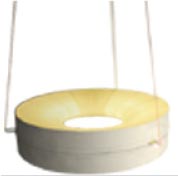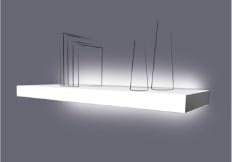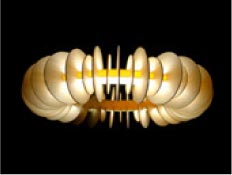|
Udvikling, produktion og markedsføring af energi- og miljørigtige armaturer til boligmarkedet Summary and conclusionsA design competition for environmentally correct and energy-saving fixtures for private homes was arranged in 2004. There were 88 entries and three were awarded with a prize. The purpose of the project was to produce and promote two or three proposals in a campaign for the use of environmentally correct and energy-saving fixtures. Three manufacturers of fixtures had given prior notice that they would produce the fixtures, but with certain conditions. Despite the many entries, the manufacturers assessed that none of them possessed the necessary qualities to commence product development. A group of designers were offered the possibility to find other manufacturers, but they did not succeed. Background and purposeDevelopment of modern compact and T5 fluorescent tubes provides new possibilities to use environmentally friendly and energy-saving lighting in private homes, but the range of low-cost fixtures is limited. Many of the fixtures suitable for energy-saving light sources have been developed for the professional market and are not suitable for the private market due to their high quality and price. The purpose of the project has been to increase the use of environmentally correct and energy-saving fixtures in private homes. The project's primary objectives were to:
The experience from the project should serve as a basis for introducing criteria for environmental labelling of fixtures (flower or swan labelling) and/or configuration of environmental declarations. The idea was conceived in the project - ”Pre-project, cleaner products and better waste management in the lighting business” - which comprised a mapping of the environmental impact of the Danish lighting sector and gave an action plan for reduction of the main impacts in the form of proposals for specific main projects. The surveyThe project was planned in the following stages:
Phase 1 – Preliminary stage was completed by the Danish Illumination Engineering Society in cooperation with Hansen & Henneberg. Planning and arranging the design competition – phases 2-3 was done by the Danish Illumination Engineering Society in cooperation with manufacturers Louis Poulsen Lighting, Frandsen Lighting and Horn Lighting. None of the manufacturers wished to continue the project. The Danish Illumination Engineering Society tried in phase 3A to find alternative partners. As a result the project stopped after phase 3A. Main conclusionsPre-stage The mapping in phase 1 showed, that there is a large potential in developing new fixtures for private homes which are suitable for the energy-saving compact or the T5 fluorescent tubes. The success of the project required that, after the competition, at least two manufacturers would produce, develop and market some of the incoming entries. Louis Poulsen Lighting, Frandsen Lighting and Horn Lighting showed a large amount of positive goodwill and supported the project and the performance of the competition with later production in mind. Each of them contributed DKK 25,000 for prizes. The designers' assessment of the competition The design competition attracted great interest among designers and architects
Manufacturers' assessment of the competition The manufacturers acknowledged that there were many exciting proposals. None of them wished to produce any of the entries. The reason was that the fixtures did not match the company style and that the potential did not align with the companies' other product ideas. Assessment of the project Even though it was not completed as planned, the project has increased focus on and awareness of environmentally correct design in the lighting business and among designers and manufacturers. In addition, the project has increased focus on the environment at the Danish Illumination Engineering Society, which has recently held a seminar about environmentally sound lighting. The seminar was about current issues in the lighting sector. The plan is to continue keeping the sector informed about environmental issues e.g. the consequences of the coming EU directive on environmental sound design. Project resultsMapping The mapping showed, that there is a great potential in developing new fixturs for the household market, which are suitable for energy-saving compact fluorescent tubes or T5 fluorescent tubes, although the colour rendering for compact fluorescent tubes and T5 fluorescent tubes is not as good as the incandescent and halogen light sources. During the mapping the types of light sources to be used in the competition were defined. ”The goal of the competition is to develop energy-saving and environmental sound fixtures for basic lighting in private homes, for places where the need for light is considerable and where the light is turned on for a long period of time”. Design competition “Fixtures for private homes” A set of conditions was made for the competition, and ”Fixtures for private homes”, as the competition was called was held in spring 2004. The competition was announced broadly in relevant media, and posters were placed at educational institutions. From the beginning, great interest was demonstrated in the competition by designers and architects. 99 people expressed an interest in participating in the competition. 88 entries were submitted from 50 different competitors. This was very satisfactory compared to experience from other competitions. The competition appealed especially to students, as well as younger designers and architects, who have not yet been established in the business. In addition many less established architect and design companies participated in the competition. Several of them found the open competition with focus on environmentally correct and energy-saving lighting for private homes interesting – since this had not been an area of interest before. The concept of the competition worked well. A leading element was that the three fixture manufacturers: Louis Poulsen Lighting, Frandsen Lighting and Horn Lighting supported the competition with a conditional offer to manufacture some of the entries and to market them in a common campaign directed towards the household market. A jury consisting of a number of interested parties from the lighting sector went through the incoming suggestions. The jury were pleased to see that a large number of the competitors were able to integrate environmental and energy aspects into their entries. Therefore the jury concluded that the competition had been an ”eye-opener” for many designers and architects, who have come to realize that the future will bring increased demands to environmental and energy aspects of electrical products. The award ceremony was held at Danmarks Designskole on September 8, 2004. Minister for the Environment Connie Hedegaard had promised to present the award, but had to cancel. First, second, and third prizes were presented of DKK 35,000, DKK 25,000 and DKK 15,000. The prizes were financed by the three manufacturers.
Continuation of the project with new manufacturers As mentioned above, none of the three manufacturers wished to continue in the project. The Danish Environmental Protection Agency and the Danish Illumination Engineering Society found, despite the rejections, that there was a great deal of interest in the fixtures. Several of the participating designers had expressed great willingness to have their fixtures put into production. The Danish Illumination Engineering Society was chosen to offer selected designers an alternative manufacturer themselves. This manufacturer should be willing to develop and market the product. The Danish Illumination Engineering Society received applications from two designers to develop their product and manufacture and market their design proposals. Unfortunately one of them withdrew his application when it turned out that he could not find the necessary sales channels on the private market. As the objective of the project was for a minimum of two fixtures from different manufacturers to be put into production, there was no longer basis for continuation of the project. Other sourcesMore information about the project, contact the Danish Illumination Engineering Society (Lysteknisk Selskab) www.lysteknisk.dk.
|


